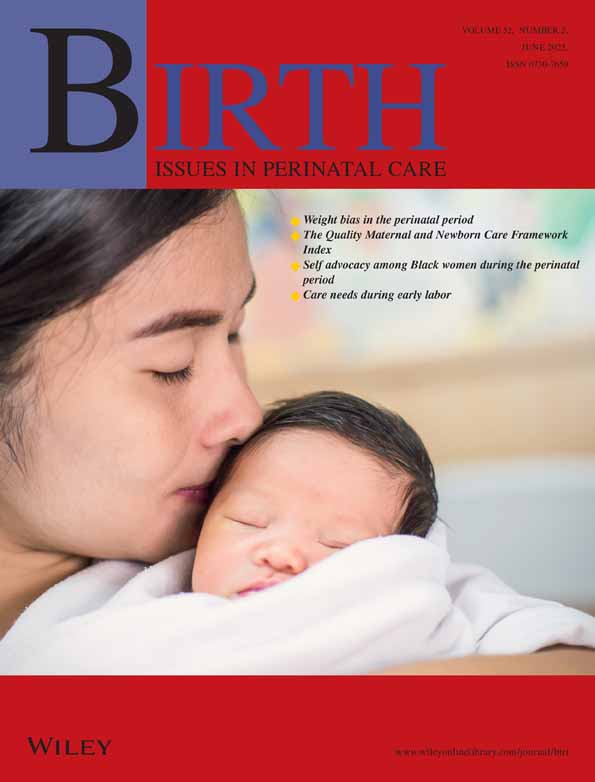BOOK AND VIDEO REVIEWS
Linda Wheeler
Lippincott-Raven Publishers, Philadelphia, 1997 288 pp, $29.95, spiral bound
The novice clinician in any specialty should have on hand a compact, thorough, evidence-based guide to care and practice, and that is what nurse-midwife and educator Linda Wheeler has achieved so successfully with her Nurse-Midwifery Handbook. She invites the new practitioner into the “circle of midwifery” by offering the framework for hands-on practice as students begin their clinical work, and by suggesting to the reader-practitioner “how to gather data, interpret it, and, in conjunction with the client and her family, follow a course of action that is safe, nurturing, respectful, and caring.” These four essentials are the key to Wheeler's approach to prenatal and postpartum care. In a refreshing, clear style she smoothly and sensitively combines the art and science of midwifery.
The text is divided into four parts—preconception counseling, initial prenatal visit, and the postpartum period (one to two-week visit and six-week checkup). A bibliography of close to 160 references, 26 appendices, and an unusually fine index follow. The book's primary emphasis is on history taking, physical examination, laboratory tests, and health education and promotion. The documentation of the scientific evidence is particularly strong and current throughout, including key texts, clinical research articles, meta-analyses and reviews, government reports, and recommendations and guidelines from professional health organizations and national and state public health agencies. In her preface, the author stresses, “As clinicians, we must read professional journals on a regular basis and make every attempt to base our practice on valid evidence.”
In addition to many helpful tables, charts, and figures, the text is enhanced by the inclusion of boxes that list questions for the clinician to ask, recommendations, criteria, laboratory values, and summarized data. Thus, the maximum amount of information and data are included in the most economical and accessible format. Scattered throughout the book as well are useful short items entitled “something fun” and “helpful hints.”
The appendices, taking up a good third of the book, cover a remarkable breadth of subjects—medical factors, physical health, psychosocial well-being, education, health promotion, and much more. They include a sample prenatal genetic screen, drug history form, environmental exposure history form, list of useful reference books on a variety of topics, the food guide pyramid and daily food guide, medical screening tool for mental disorders, responses to a disclosure of childhood sexual abuse, guidelines for working with an interpreter, initial visit history topics and charting, chart for estimating body mass index, information on female genital mutilation, positive tuberculosis skin test criteria, antepartum revisit form, models for drawing on a mother's abdomen, sample birth plan, guidelines for preparing children for childbirth with a list of helpful books, words found difficult by women with low literacy skills, questions that pregnant women often ask, postpartum patient history form, suggestions for discussing condom use with a man, and relief measures for the common discomforts of pregnancy.
The book devotes 25 pages to preconception counseling, 120 pages to prenatal care, and 20 pages to postpartum care. It is the latter part that could be expanded in a later edition, I believe, especially emotional and psychological issues, which are more completely addressed in the prenatal period sections. Maternal feelings about the birth and baby, anxiety, stress, and realignment of family relationships need elaboration. Sleep difficulties and new parent coping skills should be mentioned. Although the author notes that “the health care provider may have minimal time available to discuss emotional responses to a new baby, or medical problems with a psychological component,” in keeping with the book's format a box containing a list of “Questions to ask about postpartum mental health issues” should be placed in the main text. These questions are lost among the physical health and lifestyle issues in the postpartum patient history form in the appendix. On the other hand, the book's discussion of postpartum depression, depression separate from postpartum depression, abuse (physical, emotional, sexual), and cultural factors is excellent. The appendix of useful addresses and phone numbers was almost complete—a revision should add breastfeeding support groups such as La Leche League, and childbirth education organizations such as the International Childbirth Education Association and ASPO-Lamaze.
The author tells the reader that the Nurse-Midwifery Handbook“is neither a textbook nor a cookbook. Rather, it is a guide that gives suggestions on how to ask questions and provides a framework for being thorough. The suggestions are meant to be tried on—to see what fits and what does not fit.” For its size (6 by 8 1/2 inches), this little book admirably meets the definition of “thorough” in its content, covering a large amount of information succinctly—no waffling, no wasted words here. In addition, Wheeler reminds us that “much of what we do is culturally determined ritual and may not be based in fact, but also may not consider the needs of an individual woman.” The book's important and recurring message is that “There is no one way to be a midwife,” and that the practitioner must combine evidence-based care with a strong individualized approach. If all clinicians followed this philosophy and practice, mothers and babies under their care would benefit.
Nurse-Midwifery Handbook is designed for the beginning nurse-midwife, but all midwives and other maternity caregivers will find this up-to-date and comprehensive guide equally necessary to have close at hand in their practice. Linda Wheeler has given them a how-to-do-it, informational gem.




